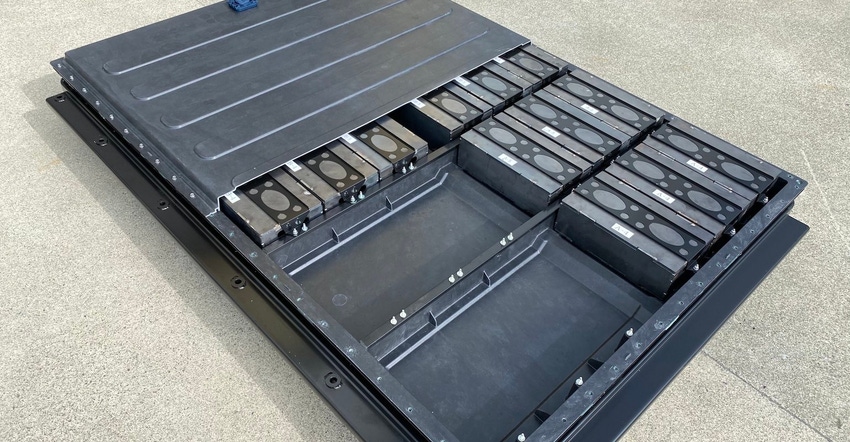Multi-material EV Battery Enclosure Takes on Heavy Metal
The one-piece composite tray does incorporate aluminum and steel reinforcements, but is 15% lighter than an all-metal version.
December 11, 2020

Continental Structural Plastics (CSP), along with its parent company Teijin, has unveiled an innovative honeycomb Class A panel technology and an advanced, multi-material EV battery enclosure that can be molded in any number of CSP’s proprietary composite formulations. These component technologies were developed at the company’s new Advanced Technologies Center located on Harmon Road in Auburn Hills, Michigan. This Advanced Technologies Center is CSP’s second R&D facility in the city.
The Advanced Technologies Center is a 47,500 square-foot facility of which 24,000 is dedicated to R&D efforts to develop next generation materials and processes to move CSP and Teijin beyond just SMC and into new markets and technologies. Equipment includes:
4000-ton press with leveling and vacuum
750-ton press with vacuum
400-ton press w/ 10’ bed
6 temperature control units
2 Fanuc robots
A coordinate measuring machine
The team at the Advanced Technologies Center currently includes five engineers and designers. CSP’s Advanced Technology Department, in combination with R&D and Product Development, is comprised of over 80 engineers, designers and scientists. Before CSP was acquired by Teijin, this facility was a Teijin R&D center, and is where the Sereebo manufacturing process was developed. This is the process now in use to manufacture the PACE Award winning GMC Sierra Denali CarbonPro pickup box – the industry’s first carbon fiber pickup box.
“We are developing technologies and processes here that leverage CSP and Teijin’s expertise in thermoplastic and thermoset composites, carbon fiber and manufacturing to provide our customers with new options for existing and future vehicle programs,” said Hugh Foran, executive director, New Business Development, New Markets & Technologies. “We can reduce weight while improving durability and occupant safety – all key features needed for autonomous, connected and electric vehicles.”
Following Teijin’s acquisition of CSP, the Advanced Technologies Center began transitioning to include broader R&D capabilities. The first of these projects is the new honeycomb manufacturing process which produces ultra-lightweight Class A panels. Considered a sandwich composite, these panels use a lightweight, honeycomb core, clad with natural fiber, glass fiber, or carbon fiber skins that are wetted with PUR resin. This process enables the molding of complex shapes and sharp edges, and results in panels that offer very high stiffness at a very low weight.
CSP is currently in development and production of more than 34 different electric vehicle battery box covers in both the US. and China. However, to expand their offering and provide customers with a superior battery enclosure, CSP and Teijin have developed a full-sized, multi-material battery enclosure featuring one-piece composite cover and one-piece composite tray with aluminum and steel reinforcements.
Automakers face a number of challenges with current multi-piece steel and aluminum EV battery enclosures, including the overall weight of case (typically more than 1,000 pounds), and the need for multiple welds, fasteners and bolts which can ultimately result in leaks. By molding the cover and the tray each as one piece, CSP has created a system which is easier to seal and can be certified prior to shipment. The company has two patents pending for its innovative box assembly and fastening systems.
The company also developed a mounting frame utilizing a structural foam for energy absorption. This enables a reduced frame thickness and weight, while improving crash performance. Additional benefits of the multi-material battery enclosure include:
Non-conductive
Can be molded in complex shapes
Less complexity in tooling
High strength
Dimensional stability
Mold-in sealing features
Ability to mold-in shielding, including EMI and RFI protection
Corrosion resistance
Reduced tooling cost
All told, the CSP multi-material battery enclosure is 15% lighter than a steel battery box. Although it is equal in weight to an aluminum enclosure, the CSP enclosure offers better temperature resistance than aluminum, especially if the phenolic resin system is used. Additionally, the one-piece design for the tray has no through holes, so no sealing or sealant are required. This not only eliminates the chance of leaks, it reduces overall production costs and complexity.
Many of these benefits could not be achieved without the superior composites chemistry developed by CSP’s materials R&D team. This assortment of advanced composites allows customers to select the formulation for the cover and/or base that best meets their specifications. CSP’s battery enclosure materials options include:
A traditional high-fill polyester/vinyl ester ATH system that uses conventional SMC chemistries, is easily adapted to existing tools and will give excellent baseline performance in the right design.
An intumescent system utilizing similar chemistry to traditional SMC, but with better flammability and thermal runaway performance.
A phenolic system which is ideal for high temperature applications where parts must meet fire safety, smoke emission, combustion and toxicity requirements. A phenolic system will have excellent flame retardance, heat and chemical resistance, and electrical non-conductivity characteristics.
Each of these chemistries can be adapted utilizing different fiber types or formats (e.g. glass/carbon/blended/other, chopped and/or continuous), and any can be formulated to achieve the most stringent VOC requirements.
“The work being done at the Advanced Technology Center, combined with the materials advancements being achieved at our R&D facility at headquarters, is enabling CSP to maintain our leadership position in advanced composites, and establish us as a global player in the multi-materials field,” said Steve Rooney, CEO of CSP. “Together with the carbon fiber and materials expertise that Teijin brings, we are developing light weight solutions that enable our customers to think outside the box when it comes to vehicle design.”
About the Author(s)
You May Also Like




